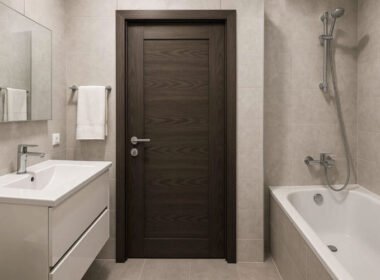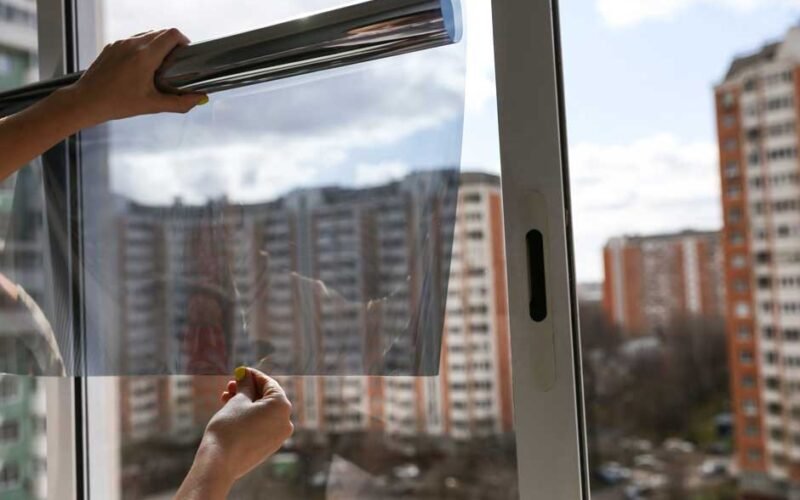Choosing the right window covering affects comfort, energy use, privacy, and style. UV window films, curtains, and blinds are common options. Each has strengths and weaknesses. This guide breaks down what each does well and where it falls short. You’ll learn which one best fits your home and needs.
What Are UV Window Films?
UV window film is a thin, transparent layer you stick onto your glass window. It blocks ultraviolet (UV) rays, reduces glare, and cuts heat. You can apply it yourself or hire a pro. Films come in solar control, privacy, decorative, and tinted versions.
Key Benefits of UV Window Film
- Blocks UV rays: It can block 99% of UV light. That protects furniture, floors, and art.
- Reduces heat: Films cut solar heat gaining by 30–80%. That can lower your air-conditioning costs.
- Less glare:Enjoy a comfortable view without annoying glare.
- Keep the view:You still see the outside clearly.
- No style change:Films are mostly invisible and don’t obstruct your view.
- Rain noise reduction: Some thick films dampen rain sounds.
Downsides to Consider
- No light blocking: Films don’t block all light. Rooms won’t go fully dark.
- Permanent choice: Once applied, removing the film may leave residue or harm the glass.
- Initial cost: Quality films can cost, and professional installation adds to it.
- No visual privacy: At night, illuminated rooms can still be seen from outside.
What Are Curtains?
Curtains are fabric panels you hang from rods above your windows. They can open and close and come in many styles, colors, and materials.
Key Benefits of Curtains
- Light control:You choose from sheer to blackout. Blackout curtains can darken a room completely.
- Decoration:Curtains add texture, color, and style. They’re a key element of interior design.
- Insulation: Thick-lined curtains can reduce heat loss in winter and heat gain in summer.
- Noise reduction: Heavier fabrics can absorb sound and reduce echo.
Downsides to Consider
- Space needed: They extend into the room when open and closed, which may crowd small spaces.
- Cleaning required: Fabric gathers dust and needs frequent washing or dry cleaning.
- Cost varies: Custom or designer curtains can get expensive.
- Manual operation:Opening and closing usually requires you to physically move them.
What Are Blinds?
Blinds are made of slats held by cords or strings within a frame. You adjust light by tilting the slats or lifting the entire blind. Options include horizontal, vertical, roller, and Roman.
Key Benefits of Blinds
- Precise light control: Adjust slats to aim sunlight where you want it.
- Better visibility: You can tilt slats to maintain privacy but still see out.
- Minimal space:Blinds stick close to the window so they won’t crowd the room.
- Easy to maintain: Wipe slats with a cloth—no laundering needed.
- Customization: Many materials, colors, and types to fit any décor.
Downsides to Consider
- Privacy gaps:Slats may not close tightly, letting in some light or view from the outside.
- Less insulation: Thin slats offer less thermal protection than thick curtains.
- Noise: Slats clink together or against window frames in windy weather.
- Wear and tear: Cords and slats can break over time, especially with kids or pets.
Side-by-Side Comparison
| Feature | UV Window Film | Curtains | Blinds |
| UV Protection | Up to 99% UV blocked | Varies by fabric (light curtains offer little) | Minimal unless lined with UV-filtering fabric |
| Light Control | Translucent; reduces glare, not light | Sheer to blackout, full darkness possible | Adjustable slats for variable control |
| Energy Efficiency | Reduces solar heat gain | Thick curtains reduce heat loss/gain | Reflective slats help but not as much |
| Privacy | No night-time privacy | Full privacy when closed | Moderate when slats closed |
| Noise Reduction | Slight rain noise damping | Good with thick or lined curtains | Low, may rattle in wind |
| Cleaning Effort | Wipe clean; no laundering | Requires washing/dry cleaning | Wipe clean; easy maintenance |
| Visual Appeal | Invisible, sleek look | Decorative, many styles/colors | Clean and modern |
| Space Usage | Saves space, flush to glass | Takes space when open | Fits close to window, space-saving |
| Initial Cost | Mid–high (film + install) | Budget to high (fabric + motion) | Budget to mid-range, depends on type |
| Lifespan | 10–15 years with UV-rated film | 5–10 years based on wear and fade | 7–15 years depending on build quality |
| DIY/Installation | Professional recommended | Easy to DIY install | DIY-friendly, frameworks widely available |
When Cabin-Level Performance Matters
Protecting Interiors from Sun Damage
If your goal is to protect floors, furniture, and art from sun fading, UV film shines. It blocks up to 99% of UV radiation without altering visibility. Curtains may need full closure to offer similar protection, and blinds often leave tiny gaps.
Cooling and HVAC Savings
UV film reflects infrared light, reducing heat gain. That helps your AC run less, especially during hot seasons. Quality window film can shrink your cooling bill by 10–25%, depending on climate and window size.
Noise Reduction Needs
Thick curtains do best with noise. Films offer modest noise damping, while blinds are least effective at blocking sound.
Need Full Darkness
For bedrooms or media rooms, blackout curtains win. They block nearly all outside light, which neither film nor blinds can achieve.
Need Precise Light Control
Blinds offer the best nuance. You can angle the slats to aim daylight just where you want it—good for workspaces or reading nooks.
Cost Comparison (Estimates)
UV Window Film
- DIY kit: $50–$200
- Professional install: $8–$12 per sq ft
Curtains
- Basic ready‑made panels: $30–$100/pair
- Mid-range custom: $150–$400/pair
- Blackout or luxury panels: $300–$1000+
Blinds
- Vinyl mini-blinds: $10–$30 per window
- Aluminum/wood-look: $30–$80
- Custom wood or motorized: $100–$250+
You may need several layers (films + curtains/blinds) to get all the benefits—like film for UV and cooling, combined with blackout curtains for darkness.
Installation & DIY Tips
| Option | Ease to DIY | Skill Needed | Help from Pro? |
| UV Window Film | Moderate | Careful cutting & smoothing required | Installation handles bubbles |
| Curtains | Easy | Basic mounting | Rods & lining best with pro |
| Blinds | Easy-moderate | Follow instructions | Motorized blinds need wiring |
DIY Tips
- For film: Clean glass thoroughly, use soapy water during installation, work out bubbles with a squeegee.
- For curtains: Use a stud-finder for heavy rods; level rods with laser or ruler.
- For blinds:Group-check slats and cords before installation; pay close attention to alignment.
Combining Options for Best Results
Sometimes pairing features creates the best solution:
- Film + Sheer Curtains
Film blocks UV and heat, sheer curtains add soft style and privacy during the day.
- Film + Blackout Curtains
Ideal for bedrooms—film reduces daylight heat and UV; curtains give full darkness.
- Film + Blinds
Film offers heat protection, blinds give adjustable light control and privacy.
- Blinds + Curtains
Blinds handle light and privacy; curtains soften the room and enhance insulation.
Eco-Friendly & Healthy Aspects
- UV Film: Helps lower energy use, saving electricity. It’s thin and uses fewer materials. Some high-quality films are recyclable.
- Curtains & Blinds:Choose organic cotton, linen, bamboo, or recycled fabrics for sustainability. Avoid PVC blinds to reduce plastic pollution.
- Indoor Air Quality: Use low-VOC materials—some films, paints, and fabrics emit volatile compounds when new.
Choosing the Right Option for You
Ask yourself:
- Do you want UV protection without blocking the view?
- Do you need full darkness for sleep?
- Is light adjustment important?
- Do you want better insulation or noise blocking?
- What’s your budget?
- How much space do you have?
- Will you install yourself or pay a pro?
Quick decisions:
- Only TV/offices→ UV film + blinds.
- Bedroom needing darkness→ Film + blackout curtains.
- Living room with view→ Film + sheer curtains.
- Simple privacy/light control → Blinds alone.
- Style & insulation first → Heavy curtains.
Maintenance & Longevity
- UV Film:Usually lasts 10–15 years. Clean with soft cloth and non-abrasive cleaner. Avoid ammonia.
- Curtains:Wash or dry clean every few months. Check lining regularly. Keep fabrics out of direct sun to prevent fading.
- Blinds: Dust and wipe slats weekly. Inspect cords and mechanisms annually for wear; replace as needed.
Environmental & Safety Considerations
- Ensure the film is certified for UV protection and energy savings.
- Use fire-retardant curtains where required (e.g., high-rise buildings).
- Follow cord safety rules for blinds around kids—use tensioners and cord safety kits to reduce hazards.
- Choose non-toxic, low-VOC materials for all window coverings.
Conclusion
There is no one-size-fits-all. Each option—UV window film, curtains, blinds—brings distinct benefits:
- UV Window Film:Clear, efficient, and space-saving solution for sun and heat protection.
- Curtains:Versatile in style, great for insulation and full light control.
- Blinds:Clean, modern, and precise with daily light adjustments.
Often, the best solution pairs two or more options. Consider your comfort, aesthetics, privacy needs, energy goals, and budget. Use this guide as a detailed roadmap. With the right choice (or combo), you’ll boost comfort, save energy, protect your interiors, and enhance your room’s look at the same time.
Frequently Asked Questions
Does UV window film reduce energy bills?
Yes. It can reduce solar heat gain and help your AC run less, cutting cooling costs by 10–25%.
Can I use film with curtains or blinds?
Absolutely. Combining film with curtains or blinds gives optimal heat control, privacy, and darkness.
How long does window film last?
High-quality, professionally installed window film lasts 10–15 years with proper care.
Which is better: curtains or blinds?
It depends. Curtains are best for style, insulation, and blackout. Blinds offer precise light control and take up less space.
Are blackout curtains worth it?
Yes for bedrooms or media rooms. They block nearly all daylight and improve sleep quality.






